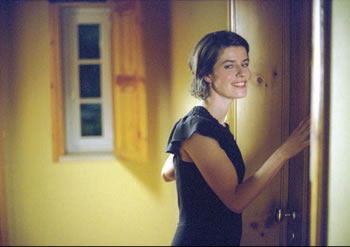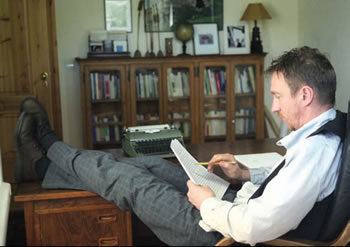HOW-TO |
||||
Check out this article in the print edition of StudentFilmmakers Magazine, September 2007. Click here to get a copy and to subscribe >>
My second experience directing – Lulu on the Bridge, which was in ’97 and ’98 – I originally wrote the screenplay for Wim Wenders to direct. But then, Wim had a conflict; he couldn’t do it. We talked about it, and he said, you know, you should direct it yourself, you’re perfectly capable of doing it. And so, I went along with it. I said, okay, I’m gonna try. I’m gonna do it. And I had a wonderful time, I must say. It was a great experience for me. And then, I took a long pause from film, and now I’ve made this new film, The Inner Life of Martin Frost. How would you describe your process for writing The Inner Life of Martin Frost? Paul Auster: Well, I don’t know. It’s like any piece of writing. You sit there, and you let your imagination go, and hope that something interesting is going to happen. How did you cast for The Inner Life of Martin Frost? Did you write the script with David Thewlis, Irène Jacob, Michael Imperioli, and your daughter, Sophie Auster, in mind? Paul Auster: Well, I actually had Irène Jacob in mind because just before I started writing the script, I knew I was going to write it, but I hadn’t started yet. I went to France, and I did a reading to her; in Paris, she read with me. And, I had met her before. I knew her a little bit. She read the French translation, and I would read the English the night before we would go to the theatre where the reading was held. A couple of nights later, we went out together, and it was raining, I remember, and she had a car. She was eight months pregnant at the time, too. She could barely get in behind the wheel. And, I looked over at her in the car, and I said to myself, this is Claire; this is my character. This is the person to play the part. And so, I told her about the start of the film script, and would she be interested in reading it when I’m finish. She said, of course. I was very, very happy when she said yes. She was the first one who got it.
And, finally, the same as David Thewlis. We had another actor who was going to do it. I can’t say who, but he backed out at the last minute for very complicated personal reasons. And so, I was stuck. I was leaving for Portugal in two weeks, and I didn’t have a lead actor. I sat down and thought to myself, who would I really want? If I could pick any English-speaking actor in the world, who do I think would be the best to do this part? And I said to myself, David Thewlis. We met once about eight or nine years before. We’ve had a nice conversation, I knew he read my books and liked them; but I didn’t know how to get in touch with him. I called a casting person, Heidi Levitt, who worked on Smoke, Blue in the Face, and Lulu with me in LA; and I asked Heidi if she can get me David’s telephone number. I couldn’t go through agents because the film had no budget, and no agent would’ve let a client see a script when they realize how little money the client was going to be paid. So I wanted to talk to David directly. It’s a funny story – I called, I left a message, and then he called me back the next day. And he said, ‘It’s so funny because I have been trying to track you down to tell you a funny story about something…’ I thought some friend of mine was playing a prank. So we emailed him the script, and the next day, he called, and he said yes.
It was just miracles, all this casting. And then Sophie, of course, is someone I know extremely well, and I thought she would be perfect for the part because you need someone young, eighteen years old who can act and sing. She is one of the few people of that age, I think, who can do it; and she did a really good job, I think. So casting turned out to be one of the least troublesome parts of the movie. Did any unique challenges come up during production? Paul Auster: Nothing terrible really. We were filming outdoors a lot; we had a lot of problems with sound. Airplanes, dogs, roosters. But we managed to somehow work around those things. Nothing major. I think in all the other movies I’ve worked on, something worse happened. This time, we were blessed. For example, the lab didn’t mess up any of the film, which happened to me on Lulu on the Bridge. Whole second day of shooting was badly processed. Smoke had different problems. But not this film. Everything went well. We were so tiny; the crew was only about eighteen people. We worked very intensely and very harmoniously together. What was your most favorite scene to shoot and why? Paul Auster: Ah! What an interesting question. Let me think, let me think. There’s a scene in the middle of the film when Martin has to get a new tire. And so, he’s rolling the tire along the road, and the tire gets away from him. I wanted to make a kind of slapstick comedy scene. We worked very hard on that, and we made it work. We had that tire rolling, rolling, and David running after it. And then, the tire kind of veers off the road, bounces off a rock, and then, bounces back, hits him, and knocks him down. Working out that little stunt – it took me a long time to figure out how to do it. I came up with a very simple solution, and it worked. And you just cut, cut, cut, and the thing worked, and I felt so satisfied that we had pulled it off.
|


